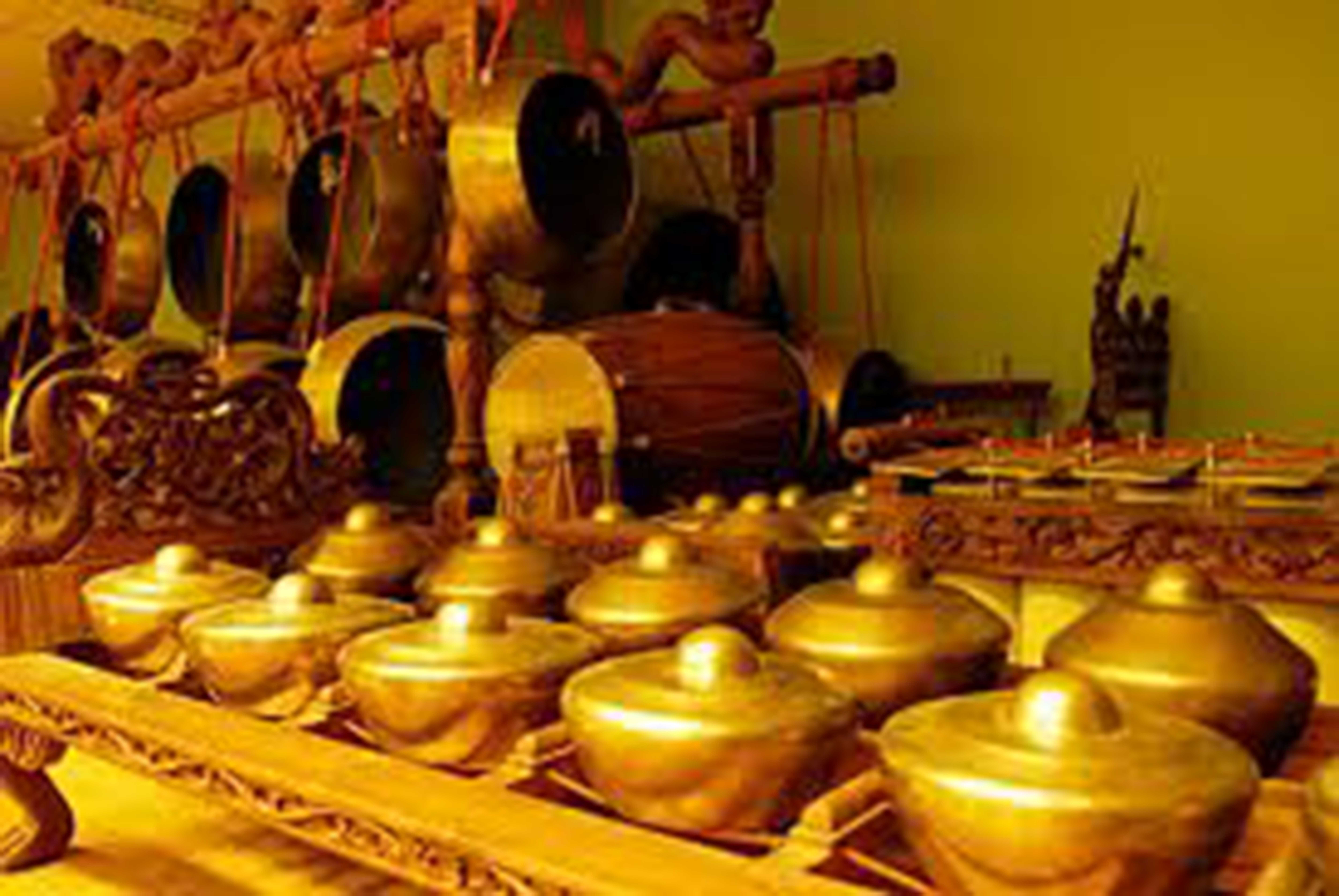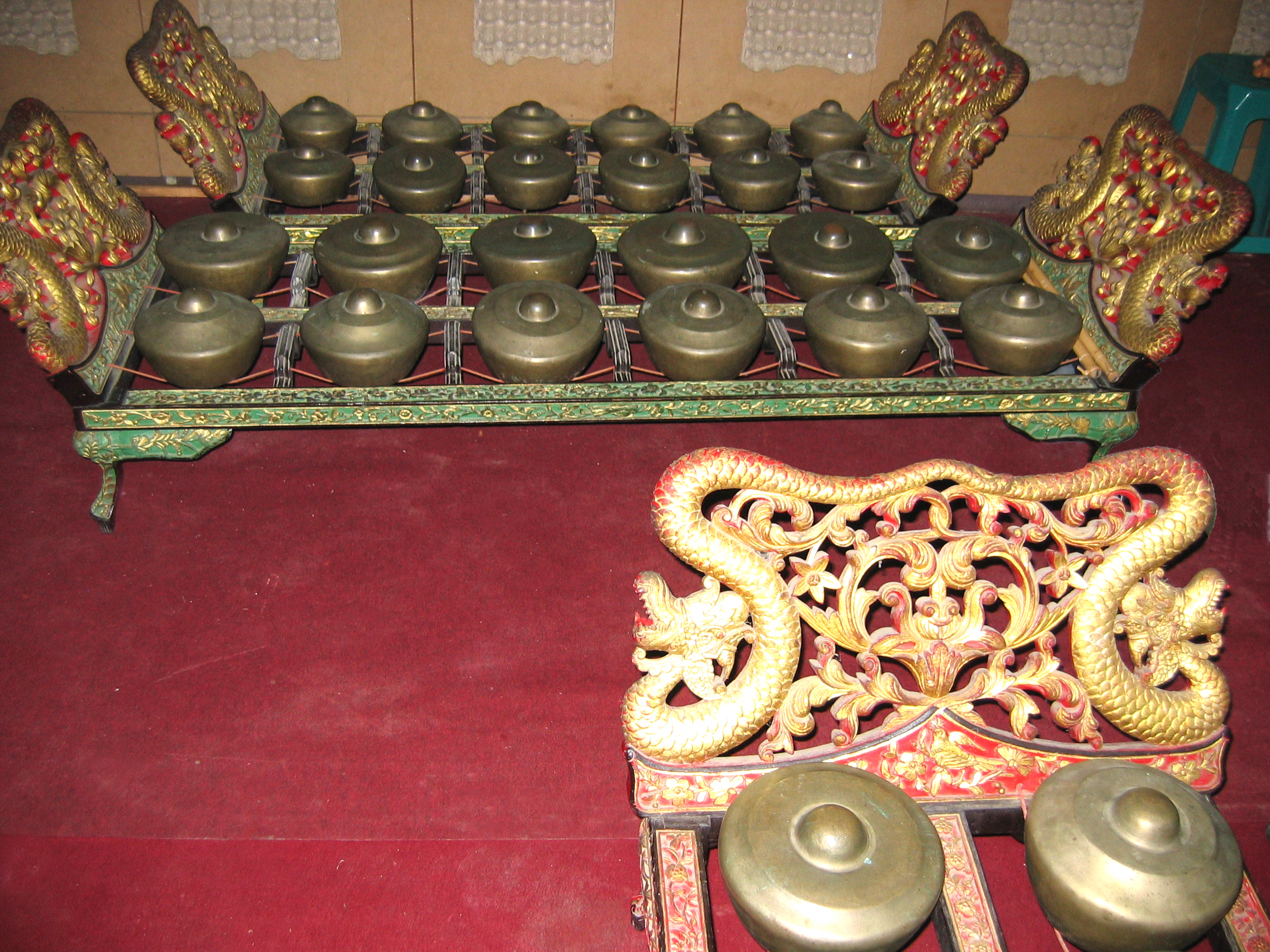|
Gong Chime
A gong chime is a generic term for a set of small, high-pitched bossed pot gongs. The gongs are ordinarily placed in order of pitch, with the boss upward on cords held in a low wooden frame. The frames can be rectangular or circular (the latter are sometimes called "gong circles"), and may have one or two rows of gongs. They are played by one to four musicians, each using two padded sticks to strike them. They are an important instrument in many Southeast Asian musical ensembles, such as Indonesian gamelan, kulintang, or Thai pi phat. For this reason, such ensembles are sometimes called "gong chime ensembles" or "gong chime orchestras," and the broad variety of music "gong chime music." Gong chimes typically are played either in a soloistic style, providing a virtuosic embellishing role, or providing a rhythmic role, for example, in a colotomic structure. The term may also be used to refer to hand-held tuned gongs played in high rhythmic density, such as the older Indonesian- Balin ... [...More Info...] [...Related Items...] OR: [Wikipedia] [Google] [Baidu] |
Traditional Indonesian Instruments02
A tradition is a belief or behavior (folk custom) passed down within a group or society with symbolic meaning or special significance with origins in the past. A component of cultural expressions and folklore, common examples include holidays or impractical but socially meaningful clothes (like lawyers' wigs or military officers' spurs), but the idea has also been applied to social norms such as greetings. Traditions can persist and evolve for thousands of years—the word ''tradition'' itself derives from the Latin ''tradere'' literally meaning to transmit, to hand over, to give for safekeeping. While it is commonly assumed that traditions have an ancient history, many traditions have been invented on purpose, whether that be political or cultural, over short periods of time. Various academic disciplines also use the word in a variety of ways. The phrase "according to tradition", or "by tradition", usually means that whatever information follows is known only by oral tradition, ... [...More Info...] [...Related Items...] OR: [Wikipedia] [Google] [Baidu] |
Kong Von Thom
The kong von thom or ''kong thom'' ( km, គងធំ) plays a melodic line in the Cambodian ''pinpeat'' ensemble almost identical to that of the roneat thung (large xylophone). The ''kong thom'' dwells more steadily on the pulse without pulling or delaying the beat (melody). The player uses soft mallets for indoor performance, hard ones for outdoors. The ''kong von thom'' is analogous to the ''khong wong yai'' used in Thailand. History The Khmer word ''korng/ kong'' "gong" is refers to all types of gong including the flat or bossed gong, single or in a set, suspended on cords from hooks, or a gong placed over a frame. The history of these gongs can be traced in part from the epigraphy and iconography of Funan-Chenla and Angkor periods, for many can be seen carved on ancient Khmer temple. Construction The gong circle-maker creates sixteen bossed gongs made of copper with bronze admixture. He suspends them on rattan frames in a circle around the player. He tunes the individua ... [...More Info...] [...Related Items...] OR: [Wikipedia] [Google] [Baidu] |
Kenong
The Kenong is a musical instrument of Indonesia used in the gamelan. It is a kind of gong and is placed on its side. It has the same length and width. Thus, it is similar to the bonang, kempyang, and ketuk, which are also cradled gongs. Kenongs are generally much larger than the aforementioned instruments. However, the kenong has a considerably higher pitch. Its sound stands out because of its unique timbre. The kenong sticks are taller than that of the bonang. The kenong is sometimes played by the same player as the kempyang and ketuk. Most of the instruments in the gamelan 'family'. are originally from Java, Indonesia but spread to Southeast Asia. The kenong usually has a specific part in the colotomic structure of the gamelan, marking off parts of a structure smaller than a gongan (the space between each strike of the gong). The interval of each part between strikes of a kenong is called a . In a fast, short structure these can only last a second or so; in a longer gendhi ... [...More Info...] [...Related Items...] OR: [Wikipedia] [Google] [Baidu] |
Gong Hui
A gongFrom Indonesian and ms, gong; jv, ꦒꦺꦴꦁ ; zh, c=鑼, p=luó; ja, , dora; km, គង ; th, ฆ้อง ; vi, cồng chiêng; as, কাঁহ is a percussion instrument originating in East Asia and Southeast Asia. Gongs are a flat, circular metal disc that is typically struck with a mallet. They can be small or large in size, and tuned or can require tuning. The earliest mention of gongs can be found in sixth century Chinese records, which mentioned the instrument to have come from a country between Tibet and Burma. The term ''gong'' ( jv, ꦒꦺꦴꦁ) originated in the Indonesian island of Java. Scientific and archaeological research has established that Burma, China, Java and Annam were the four main gong manufacturing centres of the ancient world. The gong found its way into the Western World in the 18th century, when it was also used in the percussion section of a Western-style symphony orchestra. A form of bronze cauldron gong known as a resting b ... [...More Info...] [...Related Items...] OR: [Wikipedia] [Google] [Baidu] |
Degung
''Gamelan degung'' is a form of Sundanese musical ensemble that uses a subset of modified gamelan instruments with a particular mode of ''degung'' scale. The instruments are manufactured under local conditions in towns in West Java such as Bogor and Bandung. ''Degung'' music is often played at public gatherings in West Java, such as at local elections, as well as many other events. There is international interest in ''degung'' as well among communities in other countries interested in Indonesia and gamelan music.Dewi Anggraeni"Melbourne: Gamelan, elephants and 'Jackpot'" , ''The Jakarta Post'', 22 February 2004. Gamelan degung also playable in '' madenda'' scale, which included in the set as a complementary tone, usually marked as -3/''ni'' tone in the set. Playing gamelan degung in this scale requires the substitution of the 3/''na'' metal bars into -3/''ni'' tone on all instruments. Instruments The instrumentation of ''gamelan degung'' is quite flexible. It may include: ... [...More Info...] [...Related Items...] OR: [Wikipedia] [Google] [Baidu] |
Bonang
The bonang is an Indonesian musical instrument used in the Javanese gamelan. It is a collection of small gongs (sometimes called "kettles" or "pots") placed horizontally onto strings in a wooden frame (''rancak''), either one or two rows wide. All of the kettles have a central boss, but around it the lower-pitched ones have a flattened head, while the higher ones have an arched one. Each is tuned to a specific pitch in the appropriate scale; thus there are different bonang for pelog and slendro. They are typically hit with padded sticks (''tabuh''). This is similar to the other cradled gongs in the gamelan, the kethuk, kempyang, and kenong. Bonang may be made of forged bronze, welded and cold-hammered iron, or a combination of metals. In addition to the gong-shaped form of kettles, economical bonang made of hammered iron or brass plates with raised bosses are often found in village gamelan, in Suriname-style gamelan, and in some American gamelan. In central Javanese gamela ... [...More Info...] [...Related Items...] OR: [Wikipedia] [Google] [Baidu] |
Bianzhong
Bianzhong (Chinese:编钟) is an ancient Chinese musical instrument consisting of a set of bronze bells, played melodically. China is the earliest country to manufacture and use musical chimes. They are also called Chime Bells. These sets of chime bells were used as polyphonic musical instruments and some of these bells have been dated at between 2,000 to 3,600 years old. They were hung in a wooden frame and struck with a mallet. Using a wooden hammer and a rod to beat the bronze bell can make different pitch. Along with the stone chimes called ''bianqing'', they were an important instrument in China's ritual and court music going back to ancient times. Several sets of ''bianzhong'' were imported to the Korean court during the Song Dynasty. Pronounced in Korean as pyeonjong, the instrument became an important part in Korea's ritual and court music and is still in use. In Vietnam, the instrument, which was used in ceremonies in the court at Huế, is called biên chung. The instr ... [...More Info...] [...Related Items...] OR: [Wikipedia] [Google] [Baidu] |
Lithophone
A lithophone is a musical instrument consisting of a rock or pieces of rock which are struck to produce musical notes. Notes may be sounded in combination (producing harmony) or in succession (melody). It is an idiophone comparable to instruments such as the glockenspiel, vibraphone, xylophone and marimba. In the Hornbostel-Sachs classification system, lithophones are designated as '111.22' – directly-struck percussion plaques. Notable examples A rudimentary form of lithophone is the "rock gong", usually a natural rock formation opportunistically adapted to produce musical tones, such as that on Mfangano Island, in Lake Victoria, Kenya. The Great Stalacpipe Organ of Luray Caverns, Virginia, USA uses 37 stalactites to produce the Western scale. Other stalactite lithophones are at Tenkasi in South India, and at Ringing Rocks Park in Pennsylvania. An example that is no longer used is at Cave of the Winds, in Colorado Springs. The Txalaparta (or Chalaparta), a tradition ... [...More Info...] [...Related Items...] OR: [Wikipedia] [Google] [Baidu] |







